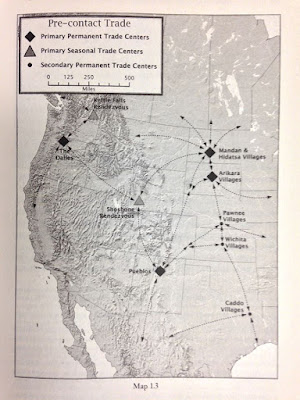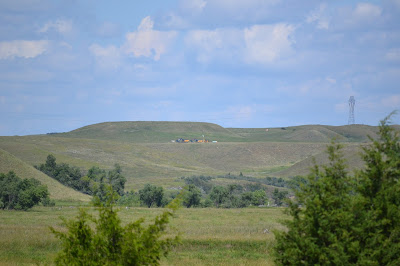DAPL machinery waits on the north bluff of the Cannonball River.
Cannonball
Íŋyaŋwakaǧapi Wakpá
By Dr. Tom Isern
Fargo, ND - It’s all quiet on the Cannonball. For
the moment. This is a good time to reflect on how we got to the point where an
out-of-state energy transport company, here operating under the (rather ironic)
name Dakota Access, manipulated our sworn officers of the law into
confrontation with the native citizens of North Dakota.
Bear with me on this, because it
requires some attention span. And there is required reading, too. Begin with a document on this page: http://history.nd.gov/hp/sire.html...
Here’s why I think you should look at
this obscure manual of practice. Issued by the Historic Preservation Department
of the State Historical Society of North Dakota, it details the requirements
for “Cultural Resource Inventory Projects.” Yeah, I know, I think they meant to
say “Inventory,” but that’s not the point. The manual codifies the expectations
of cultural resource contractors--usually archaeologists--submitting work for
review. This includes the studies required parcel to environmental assessments
for construction projects, such as the Dakota Access pipeline.
All such work, like any reputable
science, begins with a literature review. Now, archaeologists like to do field
work. They aren’t so keen about book work. So, the authors of the guidelines
spelled out clearly what they expected every research entity to accomplish with
the literature review. You can read for yourself in the manual, but I will
summarize here the three essential points.
1.
Review
the site files and other materials already of record in the historic
preservation department.
2.
Make
use of the published, textual sources for history and archaeology in the study
area.
3.
Interview
persons with personal knowledge of the area.
But, really, isn’t archaeology about
fieldwork? Why bother with this review-of-literature stuff?
Because, North Dakota is a huge place.
Even a defined study area is too large to cover foot-by-foot with pedestrian
survey. You need that boots-on-the-ground work, but if you’re just walking
around out there, or even working the ground in systematic fashion, you’re
going to miss a lot of stuff.
Think of it like this. If I start
walking across a 5000-acre pasture looking for sharptail grouse, on my own, I
may or may not be lucky enough to stumble across one. But if I start across
guided by my trusty retriever, and follow where she leads me, I will find birds
just about every time. You have to hunt where the birds are.
Historical sources tell you where to
concentrate your survey efforts, so that you actually find stuff. Maybe that’s
the problem here. If you want to find stuff, you consult the sources. If you don’t
want to find stuff, don’t look at the sources.
Wait a minute, why would a researcher
not want to find stuff? I’m a researcher, and I love to find stuff! The answer
is, these cultural resource contractors work for the people, like Dakota
Access, who want to build things, in ways that do violence to heritage
resources, if you’re not careful. When cultural resource surveyors find things,
that’s nothing but trouble for the people who pay them.
At this point, if you’re unfamiliar with
the system of cultural resource management, you’re wondering how this makes
sense. The point is, it does not. We set up a process ostensibly intended to
safeguard our heritage resources. To do this, we require that before a party
goes ahead with a big project, it has to submit a cultural resource survey and
establish that the project will not do unreasonable amounts of damage to
historic and archeological resources. Such a study is supposed to identify and
locate the resources to be safeguarded. The study is conducted, however, by a
contractor hired by the party desiring to do the project, such as the Dakota
Access pipeline. Dakota Access pays the bills. Moreover, the companies who do
such cultural resource work specialize in it and depend, for their existence
and profit, on repeat business. The incentive, therefore, is not to find stuff,
to go through the motions, but to bring in a report that satisfies the company
which pays the bill.
You can read the environmental
assessment for the Dakota Access project here: http://cdm16021.contentdm.oclc.org/...
I also have seen sections of the
cultural resource study that is part of the EA. The cultural resource study is
not included in the online posting. It is withheld because if people knew where
to find archeological sites, they might loot them for artifacts. Such caution
is standard practice, allowed by state statute--although it appears in this
case to be redundant, because at least in the section dealing with Morton
County, the researchers, surprise, didn’t find anything.
And why didn’t they find anything?
Because, far as I can see, there is no evidence the cultural resource
contractors even pretended to meet the minimum requirements for documentary
research. And because of that failure, they missed known sites of profound
significance and importance--some of them, in fact, visible in Google Earth,
for Pete’s sake.
It is time for concerned parties to
examine the primary text on this matter, the cultural resource study on file in
the historic preservation department of the state historical society, and to
determine to what degree, if any, it meets requirements for such surveys. I
have seen enough to know it is deficient. The only question is, how deficient.
Now would be an excellent time for the Standing Rock Sioux Tribe to organize a
qualified investigative team and dispatch it to the heritage center to
determine the extent of deficiency. The findings would be important to legal
proceedings currently in progress. It appears that all regulatory approvals of
the Dakota Access project have been based on faulty intelligence.
There is a final issue I must address,
although it pains me. I am a historian, and a sustaining member of the State
Historical Society of North Dakota. The cultural resource study for the Dakota
Access project came to the historic preservation department of the SHSND for
review; the department accepted it, despite its failure to meet requirements;
and thus it certified to the North Dakota Public Service Commission and other
agencies that the Dakota Access project would do no harm to heritage resources.
The statement of the SHSND, in its letter of 26 April 2016, was unequivocal:
“No Historic Properties Affected.” That statement was based on demonstrably
deficient studies.
How can this happen? There are three
possible explanations.
1.
Time
constraints - the SHSND simply lacked the staff to exercise due diligence.
2.
Lack
of competence - the SHSND dropped the ball.
3.
Conflict
of interest - the SHSND averted it gaze.
That third possibility, conflict of
interest, is most disturbing. Energy firms are seven-figure donors to the
SHSND. In fact, when the legislature only partially funded the new North Dakota
Heritage Center, the SHSND made it known that it looked to energy companies as
its main reliance for funding. And so it was done.
Let me make this plain: I am not
accusing anyone, or any agency, of wrongdoing or bias. I am saying that so long
as this conflict of interest exists, the public will view the pronouncements of
the SHSND with suspicion.
It is long past time for the SHSND to
deal with this problem. It is possible, through a transparent process of
recusal by conflicted parties and involvement of unbiased reviewers, to solve
it. As a member of the SHSND, I say, let this reform commence immediately.















